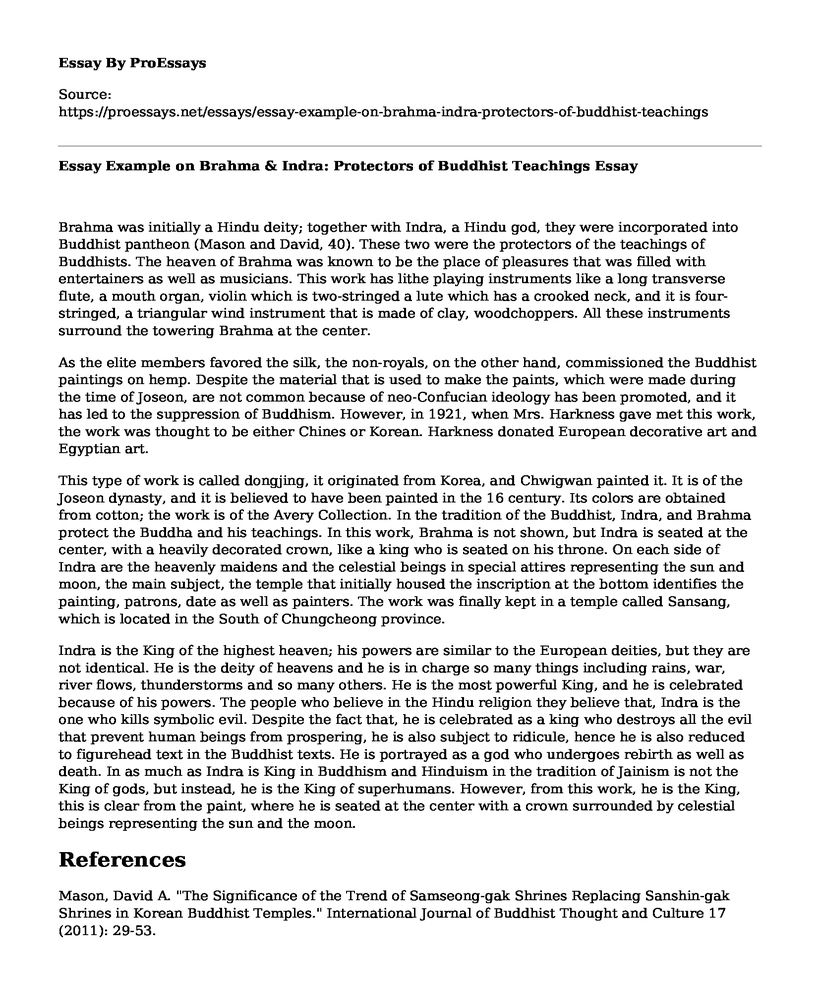Brahma was initially a Hindu deity; together with Indra, a Hindu god, they were incorporated into Buddhist pantheon (Mason and David, 40). These two were the protectors of the teachings of Buddhists. The heaven of Brahma was known to be the place of pleasures that was filled with entertainers as well as musicians. This work has lithe playing instruments like a long transverse flute, a mouth organ, violin which is two-stringed a lute which has a crooked neck, and it is four-stringed, a triangular wind instrument that is made of clay, woodchoppers. All these instruments surround the towering Brahma at the center.
As the elite members favored the silk, the non-royals, on the other hand, commissioned the Buddhist paintings on hemp. Despite the material that is used to make the paints, which were made during the time of Joseon, are not common because of neo-Confucian ideology has been promoted, and it has led to the suppression of Buddhism. However, in 1921, when Mrs. Harkness gave met this work, the work was thought to be either Chines or Korean. Harkness donated European decorative art and Egyptian art.
This type of work is called dongjing, it originated from Korea, and Chwigwan painted it. It is of the Joseon dynasty, and it is believed to have been painted in the 16 century. Its colors are obtained from cotton; the work is of the Avery Collection. In the tradition of the Buddhist, Indra, and Brahma protect the Buddha and his teachings. In this work, Brahma is not shown, but Indra is seated at the center, with a heavily decorated crown, like a king who is seated on his throne. On each side of Indra are the heavenly maidens and the celestial beings in special attires representing the sun and moon, the main subject, the temple that initially housed the inscription at the bottom identifies the painting, patrons, date as well as painters. The work was finally kept in a temple called Sansang, which is located in the South of Chungcheong province.
Indra is the King of the highest heaven; his powers are similar to the European deities, but they are not identical. He is the deity of heavens and he is in charge so many things including rains, war, river flows, thunderstorms and so many others. He is the most powerful King, and he is celebrated because of his powers. The people who believe in the Hindu religion they believe that, Indra is the one who kills symbolic evil. Despite the fact that, he is celebrated as a king who destroys all the evil that prevent human beings from prospering, he is also subject to ridicule, hence he is also reduced to figurehead text in the Buddhist texts. He is portrayed as a god who undergoes rebirth as well as death. In as much as Indra is King in Buddhism and Hinduism in the tradition of Jainism is not the King of gods, but instead, he is the King of superhumans. However, from this work, he is the King, this is clear from the paint, where he is seated at the center with a crown surrounded by celestial beings representing the sun and the moon.
References
Mason, David A. "The Significance of the Trend of Samseong-gak Shrines Replacing Sanshin-gak Shrines in Korean Buddhist Temples." International Journal of Buddhist Thought and Culture 17 (2011): 29-53.
Cite this page
Essay Example on Brahma & Indra: Protectors of Buddhist Teachings. (2023, Apr 09). Retrieved from https://proessays.net/essays/essay-example-on-brahma-indra-protectors-of-buddhist-teachings
If you are the original author of this essay and no longer wish to have it published on the ProEssays website, please click below to request its removal:
- Omniscience of God Essay
- Paper Example on Tolerance and Coercion in Islam
- Article Analysis Essay on Spirituality and Religion in Counselling
- Jericho Bible Story Essay Prompts
- The Connection Between the Synoptic Gospel and the Gospel of John Essay
- Essay Sample on The Baptism of Jesus: A Significant Event in Christianity
- Free Essay - Cultural Artifacts and Traditions: Exploring the Rich Heritage of Islamic Objects and Practices







